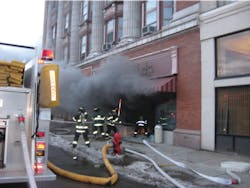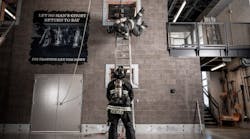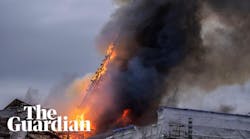Firefighters in Dunkirk, NY, faced numerous challenges — among them, insufficient manpower on the initial alarm, a municipal water system that could not meet the incident's flow demands, overtaxed communications, heavy snow and rapidly forming ice — when they responded to a downtown commercial fire that destroyed the town's historic Masonic Temple building.
The five-alarm fire on Wednesday, Feb. 24, 2010, was the largest fire to strike Dunkirk since 1953. The four-story, Type III (ordinary construction) building was built in 1908 and contained a full basement. The wooden deck roof was covered with a combination of rubber and rolled asphalt roofing materials. The building was 50 feet high in the front and 60 feet high in the rear and measured 140 by 90 feet. Each floor contained approximately 12,600 square feet of usable space.
The first floor contained 6,000 square feet for Chautauqua Works (an agency that serves job seekers, workers and employers), 6,000 square feet for a doctor's office and 600 feet for the main entrance. The second floor had 4,000 square feet of office space and the Baptist Church occupied 8,000 square feet. The third floor contained 4,000 square feet of office space and 8,000 square feet for a karate studio. The fourth floor contained 4,000 square feet of office space and a dance studio occupied 8,000 square feet. The only fire detection system in the building was in the doctor's office on the first floor. The building was not sprinklered.
Initial Conditions
The Dunkirk Fire Department was dispatched at 5:16 P.M. to a commercial fire alarm at Dr. Hyder Alam's office on the first floor, southern section, of the Masonic Temple at 323–325 Central Ave. Engines 1 and 3, both 1,250-gpm pumpers, and Engine 4, a 1,500-gpm pumper, Ladder 1, a 110-foot aerial, and Rescue 1 responded with a total of five firefighters under the command of Lieutenant Matthew Hanlon.
Arriving firefighters did not observe any indications of a fire from the exterior of the building. Engine 1 was positioned at the A/D corner of the building on Central Avenue and fed by a 20-foot, six-inch hydrant supply hoseline. The hydrant was capable of supplying between 500 and 1,000 gpm. Engine 3 was positioned on side C and supplied with a 300-foot, five-inch hydrant supply line. This hydrant was capable of supplying between 1,000 and 1,500 gpm. Engine 4 was positioned south of the fire building on Central Avenue. Ladder 1 was positioned in front of the building on Central Avenue. Rescue 1 was positioned on Central Avenue, south of the fire building.
As firefighters entered the main entrance, they were met by four adults and 32 children, ages 5 to 8, exiting the building via the main stairway. These individuals had been in the dance studio on the fourth floor and began evacuating the building when they smelled smoke. As firefighters conducted their investigation on the first floor, they found fire in the Chautauqua Works offices in the north half of the first floor. Heavy fire involvement was located in the rear (side C) and in the enclosed ceiling spaces.
The initial attack was made with a 200-foot, 2½-inch attack line from Engine 1. Another 200-foot, 2½-inch line was stretched into the building from Engine 1 as a backup line. Firefighters placed a 150-foot, 2½-inch attack line into operation on side C from Engine 3. Off-duty Dunkirk firefighters began arriving on scene at 5:30 P.M. Hanlon transferred command to Lieutenant Michael Edwards when he arrived on the scene at 5:31.
Located on the B side of the fire building was the One Liberty Square building at 335 Central Ave. This was a two-story, concrete-block building with a steel truss, wood deck, tar and gravel roof that was attached to the fire building. This building housed offices for the Chautauqua County Department of Social Services. At 319 Central Ave. on side D of the fire building was the North County Office Building, a three-story building of ordinary construction. Numerous Chautauqua County offices were in this building.
Mutual Aid
Edwards requested mutual aid from the East Dunkirk and Fredonia fire departments at 5:34. Fredonia, a combination department, responded with Truck 18, a 118-foot articulating platform with a 1,250-gpm pump and five firefighters. East Dunkirk sent Engine 113, a 1,250-gpm pumper, and 10 firefighters.
At 5:35, interior firefighters were evacuated from the building as an exterior attack was initiated from side C, near the D corner, with a 150-foot, 2½-inch attack line from Engine 3. At approximately 5:40, crews again entered the building and resumed the interior attack. Fredonia Truck 18 was positioned at the A/B corner of the building. East Dunkirk Engine 113 was positioned at the C/D corner and supplied with a 600-foot, five-inch hydrant supply line. This hydrant was capable of supplying between 1,000 and 1,500 gpm. Firefighters stretched a 200-foot, 2½-inch attack line from Engine 113 to the C/D corner to help protect the D-side exposure.
Dunkirk Engine 2, a 1,000-gpm pumper, arrived at 5:45 P.M. and was staged near the B/C corner on Lark Street. Captain Al Loeb arrived on scene at 5:46 P.M. and assumed command of the incident. Loeb requested additional mutual aid at 5:49. The West Dunkirk Volunteer Fire Department responded with Engines 122 and 123, both 1,750-gpm pumpers, and nine firefighters. The Sheridan Volunteer Fire Department dispatched Engine 161, a 1,000-gpm pumper, and 10 firefighters.
Defensive Operations
Loeb ordered all interior crews to evacuate the building at 6:02 P.M., 46 minutes into the incident. At this time, fire had spread to all four floors and the crew operating on the first floor was encountering heavy fire conditions. It was unknown whether there was fire in the basement. The crew operating on the second floor reported heavy fire conditions at the rear of the building and they were unable to get a line on the fire.
There was not enough interior manpower to contain the fire and search crews were unable to safely continue search operations due to the heavy fire conditions. Most of the fire building had been searched and it was unlikely that any viable civilians were left in the building. All firefighters were accounted for after building evacuation. Initial defensive operations were begun using the two 2½-inch lines from Engine 3 and Engine 113. Engine 3 also placed its deck gun into operation.
At 6:03, Loeb requested mutual aid from the Westfield Volunteer Fire Department. Engine 292, a 1,500-gpm pumper, Engine 293, a 1,250-gpm pumper, and Ladder 291, a 75-foot aerial with a 1,500-gpm pump, responded with 10 firefighters.
Fredonia Truck 18 was repositioned to the C/D corner of the building, Dunkirk Engine 2 was positioned on Central Avenue, south of the fire building, and West Dunkirk Engine 123 was positioned at the intersection of West Third Street and Central Avenue and hooked onto a hydrant with 20 feet of six-inch supply line. Engine 123 supplied Dunkirk Engine 1 with a 200-foot, five-inch line from a hydrant capable of supplying 1,000 to 1,500 gpm. Sheridan Engine 161 laid a 400-foot, four-inch supply line from Truck 18 to a hydrant on Central Avenue north of Third Street. Engine 161 hooked on to the hydrant with a 20-foot, six-inch supply line and pumped to Truck 18. EMS Ambulances A2 and A60, both from WCA (a private ambulance firm) set up on Central Avenue north of the fire building. A staging area was established on Central Avenue, one block south of the fire scene.
Command Structure
Loeb made the following command assignments: Dunkirk Fire Chief Keith Ahlstrom was assigned as safety officer; Chautauqua County Director of Emergency Operations Julius Leone as logistics officer; Chautauqua County Second Battalion Coordinator Richard Cole as staging officer; Lieutenant Gary Katta as Sector A command; Lieutenant Michael Edwards as Sector A/B command; Lieutenant Matthew Hanlon as Sector B/C command; Lieutenant Jim Hyland as Sector C/D command; and Assistant Director of Emergency Operations Bob Franks as water supply officer.
Westfield Ladder 291 was positioned on the D side and set up for aerial master stream operations. This unit was supplied by a 400-foot, four-inch line from Sheridan Engine 161, which hooked onto a hydrant north of the fire scene across the railroad tracks on Central Avenue. This hydrant was capable of supplying between 500 and 1,000 gpm. West Dunkirk Engine 122 laid 800 feet of five-inch supply line from Dunkirk Engine 4 to a hydrant at the intersection of West Fourth Street and Washington Avenue. Engine 122 hooked onto the hydrant with a 20-foot, six-inch supply line and pumped to Engine 4. This hydrant was capable of flowing between 1,500 and 2,000 gpm. West Dunkirk Engine 123 hooked onto a hydrant at the corner of West Third Street and Central Avenue with a 20-foot, six-inch supply line and supplied Dunkirk Engine 3 with a 200-foot, five-inch line. This hydrant was capable of flowing between 1,000 and 1,500 gpm.
Dunkirk Engine 2 was repositioned to a hydrant at the corner of West Fourth Street and Central Avenue and supplied Ladder 1 with a 200-foot, five-inch line. This hydrant was capable of flowing 1,000 to 1,500 gpm. Westfield Engine 293 laid 600 feet of five-inch supply line from a hydrant at the intersection of West Fourth and Eagle streets to a position along the B side of the B-exposure building. Engine 293 placed its deck gun and a 200-foot, 2½-inch attack line into operation. Westfield Engine 292 was placed in staging.
At 7:11, Loeb requested an additional aerial ladder from the Mayville Volunteer Fire Department, 26 miles away. Ladder 251, a 109-foot aerial with a 2,000-gpm pump, responded with 10 firefighters. At 7:16, the Brocton Volunteer Fire Department was asked to send an engine to the scene. Engine 202, a 1,500-gpm pumper, responded with 14 firefighters. The Cassadaga Volunteer Fire Department was called to send an engine to the scene at 7:17. Engine 101, a 2,000-gpm pumper, responded with 14 firefighters.
At 7:21, the Silver Creek Volunteer Fire Department was requested to send two engines to the scene. Engine 171, a 1,000-gpm pumper, and Engine 172, a 1,250-gpm pumper, responded with 12 firefighters. At 7:37, the Forrestville Volunteer Fire Department responded with Engine 131, a 1,500-gpm pumper, and 12 firefighters. At 7:39, the Irving Volunteer Fire Department responded with Engine 141, a 1,500-gpm pumper, with five firefighters. Fredonia Truck 18 was set up for aerial master stream operations and was supplied with a 100-foot, five-inch line from West Dunkirk Engine 123.
Structural Collapses
At 7:17 P.M., the first of several structural collapses occurred. The four-story wall on the B side of the fire building collapsed into the B-exposure building. This caused the roof and the C-side second-floor wall of the B exposure to collapse. Fire erupted on the second-floor C side of the building and was extinguished by crews from the exterior. Firefighters had been operating handlines off of the B exposure roof but had been evacuated by command 16 minutes prior to the collapse. Two other collapses occurred in the fire building, but did not cause any further damage to either exposure.
Incident commanders determined that the municipal water system could not handle the demand for firefighting operations that was needed at approximately 7:45 P.M. The municipal system could provide approximately 6,000 gpm, but could not provide the additional needed flow. It was decided to draft out of Lake Erie three blocks to the north of the fire on Central Avenue. Silver Creek Engine 172 laid 600 feet of five-inch line from Mayville Ladder 251 north on Central Avenue. Brocton Engine 261 continued laying 900 feet of four-inch line from Silver Creek Engine 172. Cassadaga Engine 131 laid 1,000 feet of five-inch line from Brocton Engine 261 to Lake Erie. Engine 131 established draft. This water supply was established at 8:30 P.M.
Silver Creek Engine 171 was positioned at the intersection of West Fourth and Eagle streets and laid a 600-foot, four-inch supply line from a hydrant located at the intersection of West Fourth and Swan streets at 9 P.M. This hydrant was capable of supplying between 1,000 and 1,500 gpm. An additional 200-foot, five-inch line was hand laid from Engine 171 to a position on Lark Street. A manifold was placed on the end of the five-inch line. Two 100-foot, 2½-inch supply lines were laid to a portable monitor on side C. This monitor was used on the C side of the B exposure.
More Water Supply
At 11:45 P.M., incident commanders decided that another water supply from Lake Erie was needed to further reduce the demand on the municipal water system and let it replenish itself for normal operations the following day. Forrestville Engine 131 laid 600 feet of five-inch line from Sheridan Engine 161, which was positioned on Central Avenue, north of Third Street. West Dunkirk Engine 123 laid 600 feet of five-inch line from Forrestville Engine 131 to the Central Avenue Boat Ramp on Lake Erie and established draft. This relay was established at 1 A.M. on Thursday.
At the height of the fire, four aerial master streams, three portable monitors, three deck guns and two 2½-inch handlines were in operation. It was estimated that 7,500 gallons of water per minute was being applied to the fire.
Loeb declared the fire under control at 3:56 A.M. on Thursday, Feb. 25. All mutual aid departments were released by 7 A.M. The last Dunkirk engine left the scene at 5 P.M. on Sunday, Feb. 28, nearly 96 hours after the initial alarm. A watch line was left in place on a hydrant and was used intermittently until 11:25 A.M. on March 2.
More than 150 career and volunteer firefighters operated 16 engines, four aerials and four rescues at the scene. Nine hydrants on the municipal water system and two drafting relays from Lake Erie supplied over 3.7 million gallons of water for firefighting operations. Two firefighters suffered minor injuries. No civilians were injured. At the time of the fire, the temperature was 33 degrees and dropped to 24 degrees with light winds that night. During the rest of the incident, temperatures ranged from 21 to 37 degrees with winds up to 14 mph. Two feet of snow fell during the incident.
Investigation
The Chautauqua County Fire Investigation Team conducted a five-day investigation into the origin and cause of the fire. It was determined that the fire was caused by an electrical short at the main service disconnect in the basement below Chautauqua Works, on the C side wall near the C/D corner. The building and its contents were destroyed, except for a few historical items recovered from the Masonic Temple.
- Successes — Thirty-two children and four adults evacuated the building without injury. Firefighters were able to search most of the fire building and all of the D exposures before interior operations were abandoned. The D exposure sustained water and smoke damage. Cooperation between all mutual aid fire departments was very good.
- Problems — Dunkirk firefighters were faced with several problems throughout the incident. The building did not have a lock box. This delayed initial entry into the building. Initial manpower staffing was not adequate for the deep-seated fire and the size of the building. Most firefighters had a lack of experience in fighting a fire in this size commercial building.
The municipal water system could not supply the necessary water flow after requirements passed 6,000 gpm and some of the distant mutual aid companies did not have the proper adapters necessary for Dunkirk hydrants.
Command was overwhelmed with the number of individuals trying to report there. Communications were difficult during the incident due to heavy radio usage. Fuel suppliers for apparatus took too long to get to the scene once requested. Rapid ice buildup created hazardous conditions for firefighters.
JAY K. BRADISH/IFPA, Firehouse® news editor, is a former captain in the Bradford Township, PA, Fire Department. He has been a volunteer firefighter and fire photographer for more than 25 years.
ON THE JOB: NEW YORK
DUNKIRK FIRE DEPARTMENT
Chief: Keith D. Ahlstrom
Personnel: 27 career firefighters, eight volunteer firefighters (combination fire department)
Stations: Three
Apparatus: Three pumpers, one aerial, one reserve pumper
Population: 16,000
Area: Four square miles






